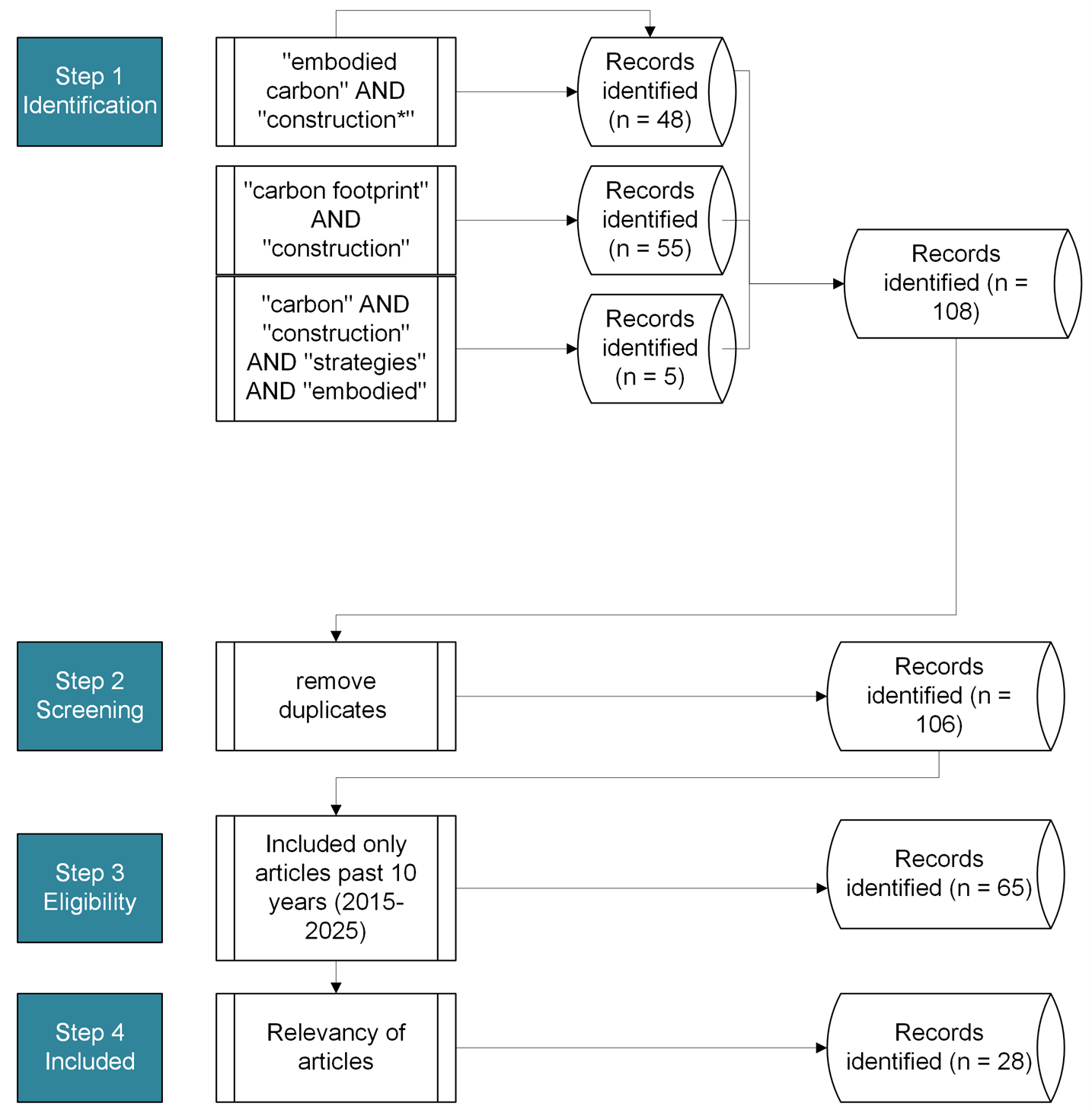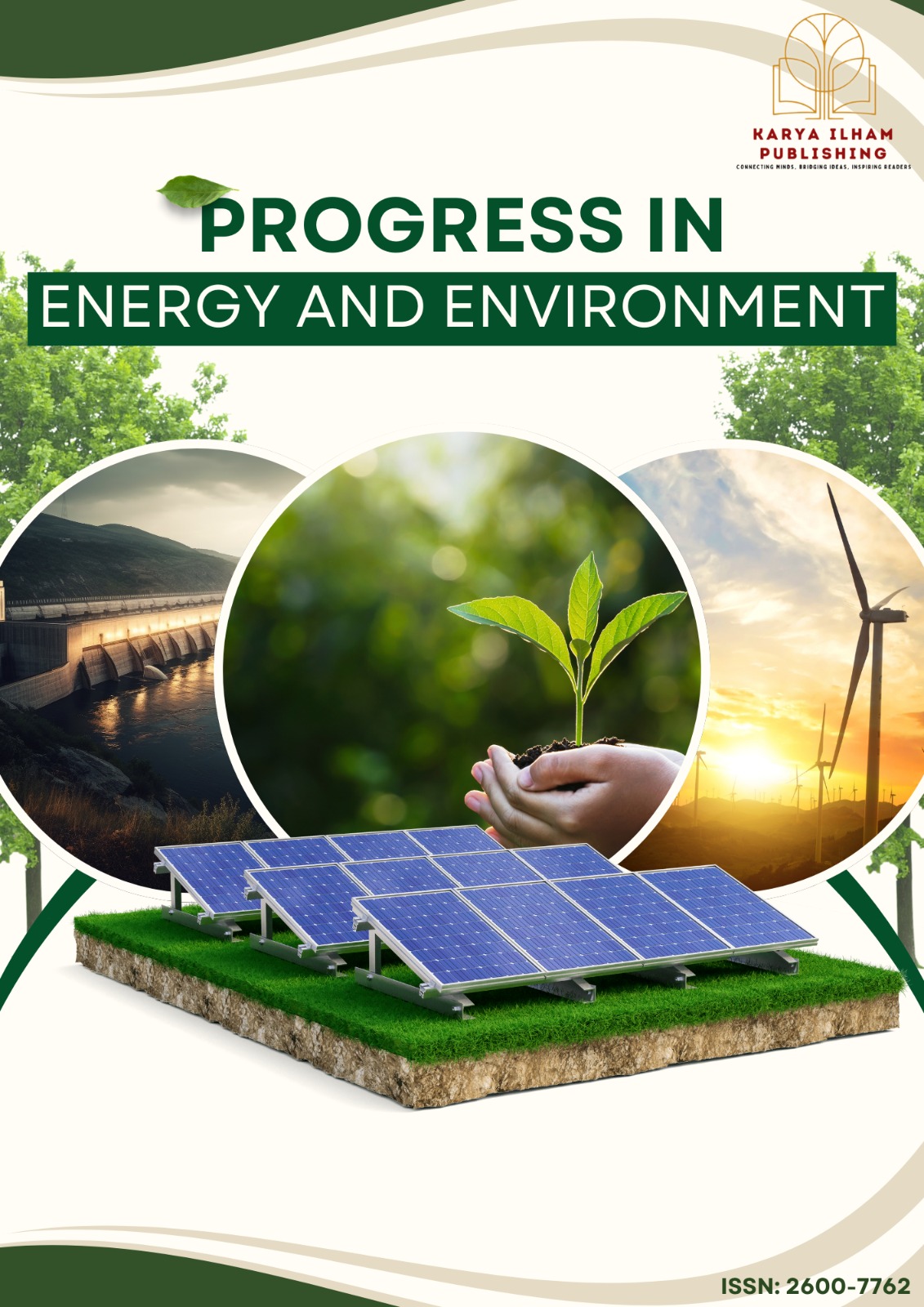Practices in Reducing Embodied Carbon in Construction in Malaysia
Amalan Mengurangkan Karbon Terbenam dalam Pembinaan di Malaysia
DOI:
https://doi.org/10.37934/progee.31.2.185196Keywords:
Embodied Carbon, Construction, Carbon Footprint, Karbon Terbenam, Pembinaan, Jejak Carbon, MampanAbstract
Embodied carbon in a construction project contributes 10% to 20% of the total global carbon emissions. Often practices in reducing embodied carbon are fragmented and relatively less emphasized as opposed to operational carbon emission. Hence this study aims to identify the practices of reducing embodied carbon in a construction project. A systematic literature review was conducted using the Preferred Reporting Items for Systematic Reviews and Meta-Analyses (PRISMA framework). A total of The final selection of sample of literature materials amounted to 28 publications published between 2015 and 2024 were analysed. The findings revealed that there are a total of 14 practices in reducing embodied carbon emission that can be adopted in a construction project. The present study contributes to the body of knowledge where it addresses the research gap that exists regarding the lack of clarity on the holistic practices for reducing embodied carbon in construction. It provides valuable insights and emphasises the areas in which improvements can be made to ensure a more robust approach to the mitigation of embodied carbon for achieving a sustainable construction.
Karbon terbenam dalam projek pembinaan menyumbang 10% hingga 20% daripada jumlah keseluruhan pelepasan karbon global. Amalan pengurangan karbon terbenam sering kali berpecah-pecah dan kurang diberi penekanan berbanding pelepasan karbon operasi. Oleh itu, kajian ini bertujuan untuk mengenal pasti tahap amalan pengurangan karbon terbenam dalam projek pembinaan. Satu kajian literatur sistematik telah dijalankan menggunakan rangka kerja ‘Preferred Reporting Items for Systematic Reviews and Meta-Analyses (PRISMA)’. Sebanyak 28 penerbitan yang diterbitkan antara tahun 2015 hingga 2024 dianalisis. Penemuan kajian menunjukkan terdapat sebanyak 14 amalan yang boleh diterapkan dalam projek pembinaan bagi mengurangkan pelepasan karbon terbenam. Kajian ini menyumbang kepada pengetahuan dengan menangani jurang penyelidikan yang wujud berkaitan kurangnya kefahaman mengenai amalan holistik dalam pengurangan karbon terbenam dalam pembinaan. Ia memberikan perspektif yang bernilai dan menekankan perkara yang memerlukan penambahbaikan untuk mewujudkan pendekatan yang lebih menyeluruh bagi mengurangkan karbon terbenam untuk mencapai pembinaan yang mampan.
References
[1] United Nations, 2021 Global Status Report for Buildings and Construction, Switzerland, 2021. https://globalabc.org/resources/publications/2021-global-status-report-buildings-and-construction.
[2] Y. Yuan, M. Qu, Q. Li, and M. Umer, Analysis of the non-equilibrium and evolutionary driving forces of carbon emissions in China’s construction industry, Journal of Building Engineering 97 (2024) 110834. https://doi.org/10.1016/j.jobe.2024.110834.
[3] N.S.A. Rahim, S. Ismail, C. Subramaniam, S.N.H. Abdullah Habib, and S. Durdyev, Building Information Modelling Strategies in Sustainable Housing Construction Projects in Malaysia, Sustainability 15 (2023) 2313. https://doi.org/10.3390/su15032313.
[4] P.X. Wong, and S.N.A. Roslan, Construction and Demolition Waste Management IN Malaysian Construction Industry – Concrete Waste Management, Infrastructure University Kuala Lumpur Research Journal 7 (2019) 26–41.
[5] H. Ritchie, and M. Roser, Malaysia: CO2 Country Profile, Our World in Data (2023). https://ourworldindata.org/co2/country/malaysia (accessed March 31, 2025).
[6] United Nations, Nationally Determined Contribution (NDC): Malaysia Climate Promise, United Nations Development Programme (2023). https://climatepromise.undp.org/what-we-do/where-we-work/malaysia (accessed March 31, 2025).
[7] S. Hamid, M. Isa, S. Felix, and N.K. Mustaffa, Sustainable Management using Recycle and Reuse of Construction Waste Materials in Malaysia, ESTEEM Academic Journal 16 (2020) 47–58.
[8] R. Razman, S.T. Khaw, N.I.F. Md Noh, J.L. Ng, A.Z. Abd Wahid, and M.N. Yasin, Readiness of Malaysia’s construction industry in adopting green building rating tools, IOP Conference Series: Earth and Environmental Science 1205 (2023) 012031. https://doi.org/10.1088/1755-1315/1205/1/012031.
[9] C.C. Ohueri, M.A. Masrom, J.A. Bamgbade, and W.I. Enegbuma, The Green BIM Process Model for Efficient Information Exchange in Sustainable Building Design (2023). https://doi.org/10.21203/rs.3.rs-3134091/v1.
[10] A. Abdullah, L. Mohamed Yusof, and R. A. Rahman, Indicators, Challenges and Strategies in Implementing Net-Zero Carbon Construction Projects, Planning Malaysia 22 (2024). https://doi.org/10.21837/pm.v22i32.1509.
[11] N.K. Mustaffa, and M.F.H. Abdul Aziz, Minimizing Emissions and Cost Through Reducing Equipment Idle Time in Concreting Operations, in: Springer, 2020: pp. 139–150. Https://doi.org/10.1007/978-981-15-1910-9_12.
[12] M. Ahmed, and L. Wong, The Barriers of the Implementation of lean Construction in Klang Valley, Malaysia, in: - IOP Conference Series: Earth and Environmental Science, 2020: p. 012043. https://doi.org/10.1088/1757-899X/932/1/012043.
[13] C.Y. Ha, T.J. Khoo, and Z.Y. Koo, Current Status of Green Building Development in Malaysia, Progress in Energy and Environment 25 (2023) 1–9. https://doi.org/10.37934/progee.25.1.19.
[14] M. Chan, Md.A.N. Masrom, and S.S. Yasin, Selection of Low-Carbon Building Materials in Construction Projects: Construction Professionals’ Perspectives, Buildings 12 (2022) 486. https://doi.org/10.3390/buildings12040486.
[15] A.T. Balasbaneh, and A.K. Bin Marsono, Strategies for Reducing Greenhouse Gas Emissions from Residential Sector by Proposing New Building Structures in Hot and Humid Climatic Conditions, Building and Environment 124 (2017) 357–368. https://doi.org/10.1016/j.buildenv.2017.08.025.
[16] M.R. Omar, A. Ayob, M.H. Zakaria, N.S.A. Rahim, H. Mokhtar, H.A. Rani, and F.A. Rahman, Perspective of Construction Building Professionals on Low-Carbon Materials in Malaysia, Journal of Construction in Developing Countries 28 (2023) 139–162. https://doi.org/10.21315/jcdc-04-22-0081.
[17] A.K. Bin Marsono, and A.T. Balasbaneh, Combinations of building construction material for residential building for the global warming mitigation for Malaysia, Construction and Building Materials 85 (2015) 100–108. https://doi.org/10.1016/j.conbuildmat.2015.03.083.
[18] N.K. Mustaffa, C.M. Mat Isa, D. Ekundayo, and V.R.A. Joseph, Barriers and Strategies for Improving Carbon Emissions Management Approaches in Malaysian Construction, Construction Economics and Building 22 (2022). https://doi.org/10.5130/AJCEB.v22i3.7909.
[19] M. Chan, Md.A.N. Masrom, and S.S. Yasin, Selection of Low-Carbon Building Materials in Construction Projects: Construction Professionals’ Perspectives, Buildings 12 (2022) 486. https://doi.org/10.3390/buildings12040486.
[20] W.N. Osman, M.N.M. Nawi, R. Saad, and R. Ismail, Factors Affecting Systematic Implementation of Reduce and Recycle in Construction Industry, International Journal of Supply Chain Management 6 (2017) 270–278.
[21] A. Ismail, N. Khaliil, S. Islamiah, and H.N. Husin, Strategies to Enlarge the Market Availability of Green Building Materials (GBM) for Construction Works: Gathering the “Low-Hanging Fruits,” Research in Management of Technology and Business 4 (2023) 1374–1387. https://doi.org/10.30880/rmtb.2023.04.01.095.
[22] Z. Ghazali, and M. Zahid, Environmental sustainability: Carbon Emission Reduction Strategies and Reporting among Malaysian Construction Companies, in: 2015 International Symposium on Technology Management and Emerging Technologies (ISTMET), IEEE, 2015: pp. 417–421. https://doi.org/10.1109/ISTMET.2015.7359070.
[23] X. Huang, W. Yan, H. Cao, S. Chen, G. Tao, and J. Zhang, Prospects for Purely Electric Construction Machinery: Mechanical Components, Control Strategies and Typical Machines, Autom Constr 164 (2024) 105477. https://doi.org/10.1016/j.autcon.2024.105477.
[24] N.K. Mustaffa, C.M. Mat Isa, D. Ekundayo, and V.R.A. Joseph, Barriers and Strategies for Improving Carbon Emissions Management Approaches in Malaysian Construction, Construction Economics and Building 22 (2022). https://doi.org/10.5130/AJCEB.v22i3.7909.
[25] A. Haruna, N. Shafiq, M.O. Ali, M. Mohammed, and S. Haruna, Design and Construction Technique for Low Embodied Energy Building: An Analytical Network Process Approach, Journal of Engineering and Technological Sciences 52 (2020) 166–180. https://doi.org/10.5614/j.eng.technol.sci.2020.52.2.3.
[26] Ts.S.D.S.N.A. Mohd Noor, M.S. Holelkusairi, D.L.A.W. Ab Wahab, Dr.I.F. Mohd Kamar, and Ts.S.M.K.A. Ramly, Identifying the Initiatives of Construction Waste Management in Malaysia towards achieving Sustainable Construction, Construction 3 (2023) 130–134. https://doi.org/10.15282/construction.v3i1.9462.
[27] H. Ibrahim, N. Jamaluddin, E. Hussein, and W.N. Muhammad, Towards Achieving Zero Wastage Material IN Construction Industry, Jurnal Penyelidikan Sains Sosial 6 (2023) 89–101.
[28] S. Kahthiravale, S. Kiyyappa, N.M.S. Ismail, M.K. Ghani, K.N.A. Bashah, Z. Abd Hamid, and H.R. Ibrahim, Stainable Waste Management Practices for the Construction Industry, The Ingenieir 82 (2020) 36–46.
[29] C.H. Lim, and N. Norazman, Construction Waste Management Strategies Towards Sustainable Practices in Malaysia, Journal of Advanced Research Design 121 (2024) 22–32. https://doi.org/10.37934/ard.121.1.2232.
[30] H. Masram, A.M. Yassin, H. Shafii, and P. Murugappah, Challenges in the Implementation of Industrialised Building System (IBS) in Klang Valley, MATEC Web of Conferences 397 (2024) 01001. https://doi.org/10.1051/matecconf/202439701001.
[31] M.S.B. Samsi, M.F. Zainuddin, F.M. Yop Zain, M.T. Saidin, M.E. Mamat, and Z. Zainal Abidin, The Readiness and Challenges in The Industrialised Building System (IBS) Adoption in Sarawak from G7 Contractors’ Perspective, Malaysian Journal of Sustainable Environment 11 (2024) 45–60. https://doi.org/10.24191/myse.v11i1.985.
[32] Z. Morshidi, M.K.F. Othman, and M. Bohari, A. Asmah, Awareness and Adoption of Lean Construction Tools to Enhance Safety in Construction Projects, International Journal of Service Management and Sustainability 7 (2022) 1–20. https://doi.org/10.24191/ijsms.v7i2.19938.
[33] M.E.A. Mohammed Ahmed, A Review on the Strategies of Lean Planning in Malaysia Construction Industry, Current Trends in Civil & Structural Engineering 9 (2023). https://doi.org/10.33552/CTCSE.2023.09.000714.
[34] K. Dziekonski, F. Mascarenhas, A.M. Mahamadu, and P. Manu, Investigation into the Key Barriers to Achieving UK “Construction 2025” Strategy Targets, Engineering Management in Production and Services 15 (2023) 116–127. https://doi.org/10.2478/emj-2023-0032.
[35] F. Razali, and H. Anuar, Adopting Building Information Modelling (BIM) Strategies among Architects, Engineers, and Contractors (AEC) in Malaysia Construction Industry, International Journal of Business and Technology Management 6 (2024) 1–15.
[36] I. Othman, Y.Y. Al-Ashmori, Y. Rahmawati, Y.H. Mugahed Amran, and M.A.M. Al-Bared, The level of Building Information Modelling (BIM) Implementation in Malaysia, Ain Shams Engineering Journal 12 (2021) 455–463. https://doi.org/10.1016/j.asej.2020.04.007.
[37] C.Y. Ha, T.J. Khoo, and Z.Y. Koo, Current Status of Green Building Development in Malaysia, Progress in Energy and Environment 25 (2023) 1–9. https://doi.org/10.37934/progee.25.1.19.
[38] W.H. Lam, C.F. Wong, O.K. Tan, and B.H. Yap, Study on the Benefits of the Implementation of Green Building Rating in Malaysia, The Journal of The Institution of Engineers Malaysia 85 (2024). https://doi.org/10.54552/v85i1.226.
[39] A.A. Setiawan, H. Hardjasaputra, and R. Soegiarso, Embodied Carbon Dioxide of Fly Ash based Geopolymer Concrete, OP Conference Series: Earth and Environmental Science1195 (2023) 012031. https://doi.org/10.1088/1755-1315/1195/1/012031.
[40] M. Robati, P. Oldfield, A.A. Nezhad, D.G. Carmichael, and A. Kuru, Carbon Value Engineering: A Framework for Integrating Embodied Carbon and Cost Reduction Strategies in Building Design, Building and Environment 192 (2021) 107620. https://doi.org/10.1016/j.buildenv.2021.107620.
[41] S. Arogundade, M. Dulaimi, and S. Ajayi, Exploring the Challenges Impeding Construction Process Carbon Reduction in the UK, International Journal of Construction Management 24 (2024) 422–431. https://doi.org/10.1080/15623599.2023.2257512.
[42] I. Bampanis, and C. Vasilatos, Recycling Concrete to Aggregates. Implications on CO2 Footprint, in: RawMat 2023, MDPI, Basel Switzerland, 2023: p. 28. https://doi.org/10.3390/materproc2023015028.
[43] T. Kumari, U. Kulathunga, T. Hewavitharana, and N. Madusanka, Embodied Carbon Reduction Strategies for High-Rise Buildings in Sri Lanka, International Journal of Construction Management 22 (2022) 2605–2613. https://doi.org/10.1080/15623599.2020.1814939.
[44] Z. Zhang, Y. Lei, J.Y.R. Liew, M. Liu, G. Wong, and H. Du, Embodied Carbon Saving Potential of using Recycled Materials as Cement Substitute in Singapore’s Buildings, Npj Materials Sustainability 2 (2024) 27. https://doi.org/10.1038/s44296-024-00032-w.
[45] W. Luo, M. Sandanayake, and G. Zhang, Direct and Indirect Carbon Emissions in Foundation Construction – Two Case Studies of Driven Precast and Cast-in-situ Piles, Journal of Cleaner Production 211 (2019) 1517–1526. https://doi.org/10.1016/j.jclepro.2018.11.244.
[46] Y. Zhu, and H. Fan, Use of Biodiesel in Non-Road Mobile Machineries for Low-Carbon Construction: Policy Review and Lifecycle Analysis, Journal of Cleaner Production 421 (2023) 138543. https://doi.org/10.1016/j.jclepro.2023.138543.
[47] V.R. Joseph, and N.K. Mustaffa, Carbon Emissions Management in Construction Operations: A Systematic Review, Engineering, Construction and Architectural Management 30 (2023) 1271–1299. https://doi.org/10.1108/ECAM-04-2021-0318.
[48] W. Wu, P. Sun, and H. Zhou, The Case Study of Carbon Emission in Building Construction Process, IOP Conference Series: Earth and Environmental Science 371 (2019) 022011. https://doi.org/10.1088/1755-1315/371/2/022011.
[49] J. Wang, H. Wu, H. Duan, G. Zillante, J. Zuo, and H. Yuan, Combining life cycle assessment and Building Information Modelling to Account for Carbon Emission of Building Demolition Waste: A Case Study, Journal of Cleaner Production 172 (2018) 3154–3166. https://doi.org/10.1016/j.jclepro.2017.11.087.
[50] S.N.S. Zaini, Nadia, Ibrahim, Siti Halipah, Darmansah, Nur Fadilah, Razali, Abdul Wafi, Tamjehi, Sitti Diana, Zaini, Afzan Ahmad, Hamza, Hasmida, and Sahimi, Energy Consumption Assessment on Industrialised Building System (IBS), Malaysian Construction Research Journal 32 (2020) 51–57.
[51] M.S. Pejić, I. Peško, M. Petrović, V. Mučenski, M. Terzić, and D. Stanojević, Reduction OF Carbon Emissions IN The Construction Industry USING Lean Practices, in: Proceedings of the Creative Construction Conference 2023, Budapest University of Technology and Economics, Online, 2023: pp. 608–615. https://doi.org/10.3311/CCC2023-079.
[52] C.-C. Osorio-Gómez, W.-M. León-Daza, A.-F. Moggio-Bessolo, A. Ospina-Alvarado, and J.-L. Ponz-Tienda, Lean Construction Impact on the Environmental Footprint of a Construction Project in Colombia: A Case Study, in: Construction Research Congress 2020, American Society of Civil Engineers, Reston, VA, 2020: pp. 379–387. https://doi.org/10.1061/9780784482889.040.
[53] N.N. Myint, and M. Shafique, Embodied Carbon Emissions of Buildings: Taking a Step Towards Net Zero Buildings, Case Studies in Construction Materials 20 (2024) e03024. https://doi.org/10.1016/j.cscm.2024.e03024.
[54] F. Abdullah, and N.S. Safa, BIM-Based Approach to Reduce GHG Emissions in Construction, American Journal of Civil Engineering (2024). https://doi.org/10.11648/j.ajce.20241201.11.
[55] A.Y. Bahaudin, E. Elias, M.N.M. Nawi, and N. Zainuddin, Construction Sustainability & Awareness amongst Contractors in the Northern Region of Malaysia, International Journal of Supply Chain Management 6 (2017) 259–264.
[56] N. Yaman, and A.F. Rashid, The Potential of Carbon Footprint Reduction of a Mid-Rise Residential Building in Sarawak, Built Environment Journal 18 (2021).

Downloads
Published
Issue
Section
License
Copyright (c) 2025 Progress in Energy and Environment

This work is licensed under a Creative Commons Attribution-NonCommercial 4.0 International License.















